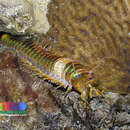Comprehensive Description
provided by Smithsonian Contributions to Zoology
Eunice aphroditois (Pallas, 1788)
Nereis aphroditois Pallas, 1788:229–230, pl. 5: figs. 1–7.
Eunice aphroditois.—Cuvier, 1817:525.—Ehlers, 1868:306–310, pl. 15: figs. 23–29.—Fauvel, 1917:215–220, fig. 18 [in part], pl. 7.
Leodice gigantea Lamarck, 1818:322.—Savigny, 1820:49–50.
MATERIAL EXAMINED.—MNHN, Paris, La Réunion, Indian Ocean, coll. M. Carrière, 1910.
COMMENTS ON MATERIAL EXAMINED.—The type material is lost; it came from Sri Lanka; the specimen here described matches the original description closely.
DESCRIPTION.—Specimen posteriorly incomplete, of unknown sex; with 529 setigers; total length 800 mm; maximal width 22 mm at setiger 25; length through setiger 10, 55 mm. Body cylindrical anteriorly, becoming dorsoventrally flattened by setiger 200, but retaining about same width through setiger 400, tapering from setiger 400 setiger to ~10 mm in width at incomplete posterior end.
Prostomium very short, distinctly narrower than peristomium, withdrawn inside nuchal fold, less than as deep as peristomium. Prostomial lobes frontally rounded, dorsally inflated; median sulcus shallow. Eyes not observed. Antennae arranged in a horseshoe, evenly spaced, similar in thickness. Ceratophores ring-shaped in all antennae, without articulations. Ceratostyles thick, digitiform, tapering slightly, without articulations. Antennae to middle of peristomium; right A-II longest, to middle of posterior peristomial ring. Peristomium massive, cylindrical, about twice as wide as prostomium. Separation between rings distinct dorsally and ventrally; anterior ring of total peristomial length. Peristomial cirri to middle of first peristomial ring, thick, slightly inflated basally, without articulations.
Jaws not examined.
Branchiae (Figure 13c, d) present, pectinate, distinctly longer than notopodial cirri, not reduced in mid-body region, erect. Branchiae from setiger 6 to end of fragment. All branchiae pectinate; maximum ~30 filaments in setigers 30–100. Stems thick, erect, tapering, longer than notopodial cirri through setiger 250. Filaments slender, filiform, shorter than notopodial cirri.
Anterior neuropodial acicular lobes truncate to rounded, becoming triangular or slightly conical in far posterior setigers; aciculae emerging at midline. Presetal lobes low, transverse folds. Postsetal lobes forming a collar around acicular lobes, about as high as acicular lobes in anterior and median setigers, projecting beyond acicular lobes in posterior setigers. Anterior ventral cirri thick, tapering from wide, triangular bases, not obviously inflated through setiger 250. Ventral cirri basally inflated in posterior half of fragment. Median and posterior bases first scoop-shaped, becoming triangular welts in last setigers present, retaining short, tapering tips in all setigers. Anterior notopodial cirri basally inflated, tapering to thick tips, becoming very large and very strongly inflated in posterior setigers (Figure 13c), by far dominant parapodial structures in far posterior setigers. All notopodial cirri without articulations.
Limbate setae longer than other setae, slender, marginally finely frayed. Pectinate setae (Figure 13a) in thick fascicles, slender; shafts flattened. Blades tapering, gently furled. Marginal teeth no longer than other teeth, with ~15 teeth. Shafts of compound hooks about as thick as aciculae and subacicular hooks, tapering, marginally smooth; beak indistinct, brass-colored. Appendages not seen. Aciculae paired, with dark brown, rarely black cores and clear sheaths, slender, tapering, distally pointed, usually bent dorsally at tip; cross-section round. Subacicular hooks (Figure 13b) with medium to dark brown cores and clear sheaths, bidentate. Hooks first present from setiger 200, thereafter missing in many setigers, always single (except for replacements). Hooks tapering to very slender, indistinct heads. Proximal teeth larger than distal teeth; both directed distally; both teeth indistinct.
UNKNOWN MORPHOLOGICAL FEATURES.—Features associated with far posterior setigers, pygidium, and anal cirri; jaw structure.
EXPECTED STATE OF SELECTED UNKNOWN FEATURES.—Mx III and IV forming distal arc; Mx VI missing.
CHARACTERS USED IN PREPARATION OF KEY NOT SCORED.—Inappropriate Characters: 56, 60. Unknown Characters: 1, 2, 6, 13, 14, 36–38, 40, 57–59, 69, 70.
ASSUMED STATES FOR PURPOSE OF PREPARING KEY.—37,1; 38,1; 57,1; 58,2; 59,2; 69,1; 70,2.
- bibliographic citation
- Fauchald, Kristian. 1992. "A Review of the Genus Eunice (Polychaeta: Eunicidae) Based upon Type Material." Smithsonian Contributions to Zoology. 1-422. https://doi.org/10.5479/si.00810282.523
Comprehensive Description
provided by Smithsonian Contributions to Zoology
Eunice flavopicta Izuka, 1912
Eunice flavopicta Izuka, 1912:121–123, pl. 14: figs. 1–5.
- bibliographic citation
- Fauchald, Kristian. 1992. "A Review of the Genus Eunice (Polychaeta: Eunicidae) Based upon Type Material." Smithsonian Contributions to Zoology. 1-422. https://doi.org/10.5479/si.00810282.523

